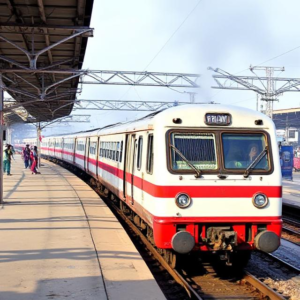Indian Railways is one of the largest railway networks in the world, and it has several policies and initiatives aimed at improving services, infrastructure, and the overall experience for both passengers and freight users. Let me explain some of these key policies and initiatives in a simple way:
1. Passenger Amenities Improvement
Indian Railways is constantly working to improve passenger services. Here are a few key initiatives:
- Cleanliness and Hygiene: Indian Railways has introduced campaigns like “Swachh Rail, Swachh Bharat” (Clean Rail, Clean India) to keep trains and stations clean. They have started installing bio-toilets to ensure cleaner trains.
- Improved Facilities at Stations: Many stations have been upgraded with better waiting rooms, more toilets, free Wi-Fi, and better parking facilities.
- Mobile Ticketing (IRCTC App): To make ticket booking easier, passengers can book tickets on their phones using the IRCTC app. They also introduced features like QR code-based ticketing to reduce the use of paper tickets.
2. Safety Measures
Safety is a top priority for Indian Railways. Several initiatives have been taken to make trains safer for passengers:
- Track and Train Monitoring: Indian Railways uses technology like the “Train Protection and Warning System” (TPWS) to avoid accidents. The system alerts train drivers in case of any signals or track problems.
- Upgrading Rail Tracks: Old tracks are being replaced with new ones to prevent accidents and allow faster trains to run.
- Anti-Collision Devices: Special devices are being fitted to trains to prevent collisions, and railway tracks are being regularly inspected for safety.

3. Digitalization and Technology
Indian Railways is embracing technology to improve its services and efficiency:
- E-Ticketing and Online Services: You can now book tickets online via the IRCTC website or app. This helps people avoid long queues at stations.
- Train Tracking and Real-Time Information: Indian Railways has set up systems for tracking trains in real-time. Passengers can check train locations, delays, and other details through the “Rail Radar” app or website.
- Wi-Fi at Stations and Trains: Free Wi-Fi services have been provided at many major railway stations across India. Some trains also offer free Wi-Fi to passengers.
4. Development of Dedicated Freight Corridors
To improve the transportation of goods, Indian Railways has developed special freight corridors. These are dedicated tracks for goods trains that do not interfere with passenger trains. This helps in faster transportation of goods and reduces delays in passenger trains. The main corridors are:
- Eastern Dedicated Freight Corridor (EDFC): From Ludhiana in Punjab to Dankuni in West Bengal.
- Western Dedicated Freight Corridor (WDFC): From Dadri in Uttar Pradesh to Jawaharlal Nehru Port in Mumbai.
5. Private Participation and Public-Private Partnerships (PPP)
Indian Railways is opening up for private sector participation in various areas, such as:
- Private Train Operators: Indian Railways has allowed private companies to operate trains on specific routes. This is expected to improve efficiency and bring in competition to enhance passenger services.
- Station Development: Private companies are being invited to develop and maintain railway stations, improving infrastructure and passenger facilities.
6. High-Speed Rail Projects (Bullet Trains)
Indian Railways is planning to introduce high-speed trains, often referred to as “bullet trains,” to provide faster travel options.
- Mumbai-Ahmedabad Bullet Train: The first bullet train project, connecting Mumbai to Ahmedabad, is under development. This train will travel at speeds of up to 320 km/h, significantly reducing travel time.
7. Environmentally Friendly Initiatives
Indian Railways is focusing on sustainability and reducing its environmental impact:
- Electrification of Tracks: Indian Railways aims to electrify all its tracks in the coming years, reducing dependence on diesel engines and lowering carbon emissions.
- Solar and Wind Power: To reduce energy costs and environmental impact, Indian Railways is setting up solar power plants on station rooftops and using renewable energy for trains and stations.
- Water Conservation: Water-saving devices like rainwater harvesting and water treatment plants are being introduced at railway stations.
8. Women-Friendly Initiatives
Indian Railways has been taking steps to make travel safer and more comfortable for women:
- Ladies Special Trains: These trains are exclusively for women and run on certain routes to ensure their safety and comfort.
- Dedicated Coaches for Women: Some trains have dedicated coaches for women, especially during peak hours.
- Security Measures: Increased presence of female RPF (Railway Protection Force) personnel and surveillance systems to ensure women’s safety.
9. Ticketing and Fare Policies
Indian Railways has introduced flexible and convenient ticketing options to suit different types of passengers:
- Dynamic Pricing: For premium trains like Rajdhani and Shatabdi, the fare is based on demand, meaning the price can go up during peak times and festivals.
- Discounts and Concessions: Indian Railways offers discounts for senior citizens, students, and certain other categories. For example, senior citizens get a discount on their train fares.
10. Railway Stations Development (Smart Stations)
Indian Railways is working on modernizing railway stations to make them “smart stations” that provide better services:
- Modern Infrastructure: Stations are being upgraded with modern facilities like escalators, elevators, better signage, and waiting lounges.
- Public-Private Partnerships (PPP): For station redevelopment, Indian Railways is collaborating with private partners to improve the stations’ facilities and services.
Summary of Key Policies and Initiatives:
- Improved Passenger Services: Cleanliness campaigns, better amenities, and mobile ticketing.
- Safety Measures: Anti-collision systems, train tracking, and better infrastructure.
- Technological Advancements: E-ticketing, Wi-Fi, and real-time train tracking.
- Dedicated Freight Corridors: Faster goods transport.
- Private Participation: Private trains and station development.
- High-Speed Rail: Bullet train projects like Mumbai-Ahmedabad.
- Environmental Sustainability: Electrification, solar energy, and water conservation.
- Women-Friendly Initiatives: Special trains and security measures for women.
- Discounts and Flexible Fares: Dynamic pricing and concessions for special categories.
These policies and initiatives aim to improve the overall experience for passengers, enhance safety, encourage sustainability, and boost the efficiency of India’s vast railway network.
Keywords: Indian Railway, Railway











